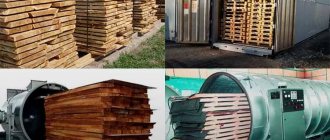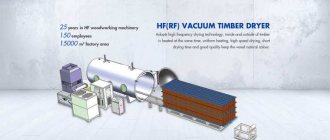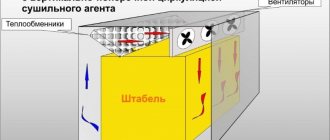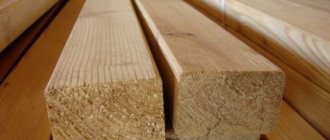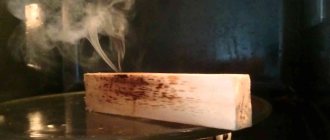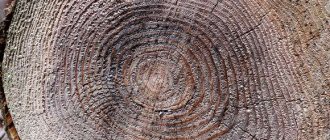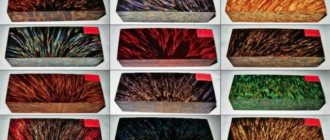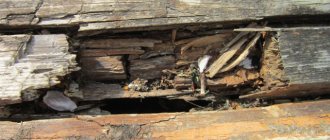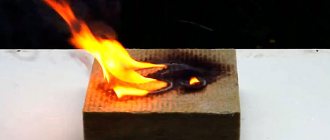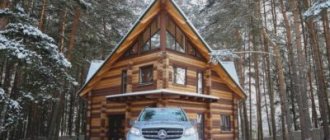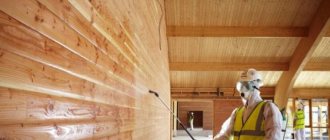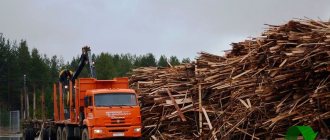A lumber dryer is an industrial piece of equipment that is used to dry raw timber for further processing. Today, wood drying in drying chambers is carried out by several types of such devices, each of which has its own specific functional features. However, in fact they are all universal. With their help you can dry any type of timber. Using the latest drying chambers, we provide high-quality drying of wood of even the most exotic and expensive varieties, for example, rosewood, beech, wenge or teak. There is no cracking or other defects.
Types of drying chambers
A large number of wood processing industries process almost 10,000 m³ of lumber every year. The wood drying chamber is a decisive link in the process chain for quality assurance. The volume of one-time loading of timber into the drying chamber varies greatly. Sometimes you need to dry 6 m³, and sometimes you need to dry up to 100 m³. The main factor when choosing the size of the drying chamber can be called production capacity.
Drying methods are classified according to the characteristics of heat transfer to the dried raw material, therefore the following types of chambers are distinguished:
- dielectric - require high energy costs
- Microwave
- convector
- vacuum Such devices are characterized by high prices and expensive maintenance.
- aerodynamic. Such devices require a lot of energy.
Chamber drying of wood using various methods was invented in the 60s of the last century, however, due to high energy costs and the complexity of the design, drying became popular only in the last decade. Convection type cameras are the most popular all over the world.
Methods for professional drying of wood
Convective (chamber) drying
The most popular type of drying equipment is convection chambers. About 80% of manufacturers use just such dryers.
Advantages: ease of use, high rate of moisture evaporation, low voltage in the final product, high loading volume (up to 1000 m3).
Supply and exhaust ventilation and heating systems (usually air heaters) are installed in the room. Humidity parameters are measured by a psychrometer and adjusted automatically. Wood waste: wood chips, slabs, sawdust is used as fuel for producing hot water or steam in small production. It is profitable to use electricity and gas only for large volumes of production, otherwise the high consumption and cost of resources will significantly reduce the cost of lumber.
Centrifugal or axial (depending on the configuration) fans ensure uniform distribution of warm air and timely removal of excess moisture to avoid warping, cracking and obtain the highest quality wood in the shortest possible time.
Price – from 160,000 rubles (depending on configuration and cargo capacity).
Atmospheric drying
The natural process of evaporation of moisture from wood, which requires a minimum of investment, but a maximum of time. However, wood dehydrated by atmospheric drying is considered the most resistant to deformation. Most often this happens like this: a tree cut down at the beginning of winter is cut into planks and kept under a canopy until the start of the construction season. In 4-6 months, the lumber has time to dry to 15-20% humidity.
To avoid deformation of the boards during the drying process, the following conditions are necessary:
- stacking on a horizontal flat surface;
- to protect against excess moisture, waterproofing is laid between the rows of stacks and in the area where drying is expected;
- so that the boards are well ventilated, the stack is placed on concrete blocks and laid with timber or unedged boards of the same thickness (see figure below);
- stacks are stacked at equal intervals and parallelism;
- a prerequisite for preventing deformation is a uniform load, which is carried out using wedges or clamping bands (see figure below);
- the finished stack is protected from atmospheric influences, covered with a profile or slate. With this arrangement of the dryer, the edged board will reach 12-18% humidity in 4-5 months. The speed and quality of dehydration depends on the climate, the amount of moisture in the atmosphere and the thickness of the board. The rules for atmospheric drying are regulated by GOST 2808.1-80 for lumber from softwood and GOST 7319-80 for hardwood.
Rice. Air dryer arrangement diagram
Rice. Loading with wedges
Main disadvantages: the structure takes up a lot of space, the drying process is uncontrolled, and in areas with high humidity there is a high risk of lumber being damaged by fungus. For such terrain, it is recommended to pre-treat the boards with an antiseptic.
Vacuum dryer
Used for drying large cross-section wood, deciduous hardwood (for example, oak), valuable wood that is susceptible to cracking. The dryer is a sealed stainless steel chamber into which boards are placed between aluminum heating plates. The top of the chamber is covered with an elastic rubber covering attached to a metal frame.
Hot water continuously circulates across the plates, which is heated by an external boiler. The vacuum inside the chamber is ensured by a pump that pumps moisture out of the room.
Rice. Vacuum chamber operation diagram
A microprocessor is used to control the processes inside the chamber. For each type of wood, the operator sets his own vacuum level and plate heating temperature. For example, a beech board with a thickness of 32 mm reaches 8% humidity in 29 hours. And a pine board with a thickness of 25 mm - in 17 hours. Therefore, the main advantage of vacuum drying is the speed of processing materials .
Disadvantages: small capacity of the chambers (up to 10 m3), high energy consumption, high internal stress due to the uneven distribution of final moisture content throughout the thickness of the material. These shortcomings are eliminated in new vacuum models, where drying is carried out using hot steam.
But the price of such cameras is high: 250,000 rubles for a loading volume of 1 m3.
Microwave dryer
The essence of the “microwave” method: the wood is saturated with moisture, which then evaporates at the level of cellular structures. Dehydration of wood is carried out with high frequency currents - 915-2500 MHz.
The electromagnetic field affects stacked lumber in the space of a metal chamber. Wood is heated at a level of 50-60 degrees, therefore it is considered close to natural conditions.
Main advantages:
- mobility;
- compact dimensions;
- the drying speed is 30% higher than that of convection chambers, with relatively low energy costs (for drying 1 m3 of pine - 550 kW/h, oak - 2000 kW/h).
Flaws:
- small loading volumes (up to 4.5 m3 for hard deciduous trees and up to 7 m3 for coniferous trees);
- the high price of magnetron generators with a fairly short service life (no more than 650 hours);
- uneven drying;
- the possibility of ignition of the material inside the chamber - the microwave method is quite new, and drying modes have not yet been developed.
Convector dryers
A convector-type wood drying chamber is used for various types of timber. Such devices have a simple design, they are inexpensive to maintain and reliable. That is why they are most popular in production.
The work is carried out due to heating from a gaseous carrier (drying agent). When heated, the raw material dries out. The drying agent can be steam, flue gas or air. The moisture released from the timber serves to additionally moisten the agent, and the excess is sucked out with the help of ventilation.
The air exchange rate in a convection dryer does not exceed 2% of the total amount, therefore, energy savings are felt.
The camera body is made of metal and is placed on a monolithic columnar foundation. The metal used for the body is carbon steel or aluminum with an anti-corrosion coating. The body is sheathed on both sides with aluminum sheets. The chamber is insulated using mineral wool in the form of slabs. You can purchase a convection chamber of both domestic and foreign production.
Why is proper drying so important?
Boards with natural moisture are larger in size than dried ones and are cheaper. This is because lumber manufacturers set tolerances based on future shrinkage and trimming.
Humidity standards:
- for building and carpentry materials – 10-18%. When manufacturing building materials, the production moisture content of wood should be equal to or be 1.25-3.5% lower than the operational moisture content in order to avoid natural drying.
- for furniture production – 8-10%.
The use of lumber with natural moisture is a gross violation of the technological process . When the wood dries naturally, it will change the width, thickness and, accordingly, the geometry of the entire product.
For example, a 50*150mm edged pine board with a natural humidity of more than 50% after a couple of months will have parameters of 48 * 138 mm (for tangential cutting) and 46 * 144 (for radial cutting). Even if we take into account that the length of the product will remain the same (on average, the deviation does not exceed 0.1%), the final difference is catastrophic!
Vacuum drying
The vacuum drying chamber for wood is designed for valuable types of timber, such as teak, wenge, rosewood and others. This unit operates from convection heating of wood and vacuum removal of excess moisture. The process takes place at a maximum temperature of +65. However, due to a vacuum pressure of 0.09 MPa, boiling occurs at 45.5. Such conditions make it possible to dry the wood without the aggressive effects of high temperature. Thus, high internal stress does not arise and the wood is not subject to cracking.
During drying, when the temperature rises to 65 degrees, the automation turns on and the electric boiler turns off. The upper layers of timber slowly cool, and moisture from within flows to drier areas. During one drying period, about 250 such cycles occur. Under such conditions, moisture is evenly drawn out along the length and depth of the material. After drying, the material is characterized by a moisture level within 4-6%.
The need to dry materials
Drying allows you to solve important problems associated with the further use of wooden blanks. After drying, the tree acquires a number of positive parameters. In the process of such processing, the following tasks are solved:
- dehydration of products occurs to the required percentage of humidity;
- physical and mechanical performance increases;
- technological properties are improved (it is more easily subject to subsequent processing);
- increased resistance to the negative effects of biological factors (formation of fungi, rotting, insect penetration);
- heat and electrical conductivity decreases;
- The consumer properties of finished products are expanding.
To solve problems associated with drying wood, the production of drying chambers based on various physical principles has been established. They are capable of carrying out dehydration operations of various types of wood.
Aerodynamic drying
Chamber drying of lumber under aerodynamic conditions has become widespread due to its fairly low price and simple design. In addition, to operate such a device, no specific knowledge of maintenance personnel is required. Profitability is achieved by drying up to 2000 m³ per year of coniferous timber.
The disadvantages include:
- high level of energy intensity of the drying process. In order to dry freshly sawn wood, 1.15-1.3 kWh is required to evaporate 1 liter of moisture. Electricity is approximately 240-290 kWh/m³
- There is no way to regulate the temperature. There is only the opportunity to slow down the rate of its increase by changing the flow area of the centrifugal fan
- it is not possible to organize technological drying according to the schedule of the “Guiding technical materials on the technology of chamber drying of wood” regimes.
This chamber is a quadrangular box. It is convenient to load wood into it by machine or along railway tracks. Drying occurs under the influence of aerodynamic energy. Warm air moves in the chamber under the influence of a special aerodynamic fan. Due to the compression of air in the chamber, the temperature on the centrifugal fan increases, namely on its blades. Consequently, aerodynamic losses become thermal energy. Heat can be pumped into the chamber reversely or dead-end, it all depends on the design features. The chamber opens only upon completion of the drying cycle.
Humidity indicators
Based on the degree of humidity, the following states of wood are distinguished:
- wet (100% humidity) – logs that have been in water for a long time (for example, transported by rafting);
- freshly cut – humidity depends on the natural growing conditions of the plant, and ranges from 50-100%;
- air-dry - material that is stored in the air (under a canopy) reaches parameters of 12-20%;
- room-dry (8-12%) – drying in a closed, heated and well-ventilated room;
- dry (humidity less than 8%) – prepared by forced moisture release.
Microwave drying
Such devices were invented quite recently. They look like a closed metal container. The work is carried out under the influence of the reflective surface of microwave waves. The operating principle is similar to that of a conventional microwave. Using a microwave chamber, raw materials of any cross-section and dimensions are dried. Microwave cameras have a simple design; settings allow you to select any wavelength.
Therefore, a wide variety of timber products can be dried. The mode of attenuation of microwave waves guarantees regulation of the temperature inside the chamber. Using reversible fans, excess moisture is removed from the system. Microwave drying is compared with dielectric drying, which is considered the most effective, but is not used in Russia due to high energy costs.
The main disadvantage is the high energy consumption, like that of aerodynamic dryers.
Wood moisture content and drying kettle
The entire drying stage can be divided into several stages:
- atmospheric conditions for drying;
- the wood drying process itself;
- intermediate and final moisture treatment;
- conditioning.
Wood moisture determination
The initial moisture content of the wood is 60%. With a humidity of 18%, its purpose is to use it in an open area or on the street. At a humidity of 10%, dried wood is used for indoor, warm rooms. If you took wood with 18% moisture content and brought it into the house, then such wood requires drying.
Moisture meter
A moisture meter is used to determine humidity. You can also determine it yourself: pick up the wood and determine the weight of the product. The weight will be different at different humidity levels - and this is noticeable to the touch. If the chips are damp, then they do not break in the hand, but are pressed, and if they are dry, they will break.
Boilers that use solid fuel are specially created and designed for drying wood at home, i.e. you can manage it yourself. You can use scraps, sawdust, substandard wood, etc. The wood drying boiler has an automated system for feeding waste into a special hopper. If you decide exactly where you are going to use the wood, you just need to set the required humidity on the boiler - and your product is ready for use. Using the boiler is quite simple.
Finished, dried wood
Choosing the right boiler and the essence of drying itself
The wood drying boiler is designed by specialists in the field to remove moisture from the wood itself using a boiler equipped with ventilation, humidification and heating. Chamber drying can be gas (using gas) and steam (using steam).
Heat is supplied by forced means, i.e. by ventilation.
Each tree species needs a specific drying chamber, which is suitable specifically for a particular wood:
- For all types of coniferous species, these are boilers designed in accordance with GOST 19773-84.
- For all types of hardwood - this is GOST 18867-84.
The technological process is approximately this: boards of the same size are stacked evenly on top of each other on a cart that is used to transport wood and delivered to the drying chamber. This installation is placed in a gaseous room, drying the material to the required humidity, selecting the appropriate drying mode: soft, normal, forced, high temperature. All modes comply with GOST.
Drying is selected based on the thickness of the wood, species and where the material will be used. The drying chamber is divided into 3 air supply options. The temperature in the boiler cannot be changed abruptly, it can only be done by gradually lowering the temperature: for example, if the wood moisture content is 30%, then we first dry it at stage 1, and then move on to stage 2 drying. If the moisture content of the material is 20%, then we first dry it at 2 stages, only then move on to the 3rd stage of drying.
Wood drying chamber
Drying chamber fence
To isolate the wood from the effects of the environment, a chamber fence is installed, which consists of a floor, ceiling, walls and intermediate partitions. Requirements for partitions:
- should not allow steam to pass through;
- fences must have low thermal conductivity;
- must have a long service life.
Fences are made separately from various building materials or can be prefabricated with a set of standard metal elements.
The first type of cameras has a longer operating life, but has a longer commissioning time, which is not always justified. Prefabricated metal frames are installed quickly, they are equipped with control and thermal devices, but the steel is subject to the destructive effects of wet and thermal conditions.
Basic equipment for dryers
Whatever type of forced wood drying chamber is used, standard groups of equipment are allocated for all.
Transportation equipment is designed for loading and unloading logs or boards into the drying room. Includes machines and mechanical devices for storing workpieces in a stack or package, and carries out raising and lowering of lumber.
The thermal equipment of the chamber serves to raise the temperature of the internal air in the chamber and consists of many systems that determine the interconnected work of producing and transferring heat. These include heat exchange tanks, heaters, pipes for the passage of steam or hot water, devices for removing condensate, shut-off valves and control devices.
The fuel is gas and liquid fuel. For small volumes of work, a drying chamber for wood-burning lumber is equipped. The coolant is saturated steam, water, gas obtained from combustion of the furnace, and organic fillers of the system that have a high boiling point. Electric heaters are widely used, where current energy is converted into a thermal component.
Circulation equipment is designed for the organized movement of air masses in the drying chamber. The elements of the system are fans, injectors and joint installations of these elements. To increase the efficiency of wood drying, automation of lumber drying chambers is used.
Wood moisture concept
The percentage ratio of the weight of the liquid contained to the weight of completely dry wood of a certain volume is called absolute humidity. The percentage of the mass of water removed (determined by two weighings) to the original weight of the wood is called relative humidity.
The degree of suitability for use is determined taking into account the relative humidity indicator. The value indicates the readiness of the material for gluing and drying; with a value above 30%, there is a danger of developing a fungal infection.
Depending on the indicator, wood is divided into categories:
- wet - with a relative humidity of more than 23%;
- semi-dry – within the range from 18 to 23%;
- dry – with a humidity value from 6 to 18%.
The advantages of such a boiler
This drying is the most effective and suitable option. He has the following qualities:
- it does not depend in any way on weather conditions;
- a small amount of defects;
- all work is automated;
- convenient and simple program management;
- ultimately we obtain wood with the required moisture content;
- maintains uniform drying and shape.
Such drying boilers can solve several problems at once and, according to their characteristics, are the most economical equipment for drying wood.
